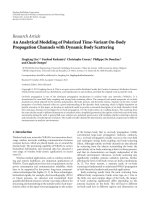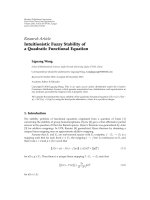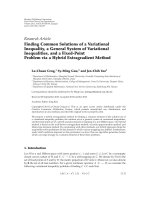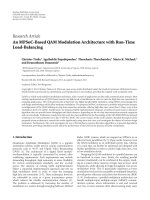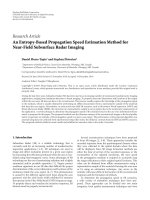báo cáo hóa học:" Research Article An FPGA Implementation of a Parallelized MT19937 Uniform Random Number Generator" pptx
Bạn đang xem bản rút gọn của tài liệu. Xem và tải ngay bản đầy đủ của tài liệu tại đây (591.88 KB, 6 trang )
Hindawi Publishing Corporation
EURASIP Journal on Embedded Systems
Volume 2009, Article ID 507426, 6 pages
doi:10.1155/2009/507426
Research Article
An FPGA Implementation of a Parallelized MT19937 Uniform
Random Number Generator
Vinay Sriram and David Kearney
University of South Australia, Reconfigurable computing Laboratory, School of Computer and Information Science,
Mawson Lakes Campus, Adelaide, SA 5085, Australia
Correspondence should be addressed to Vinay Sriram,
Received 20 August 2008; Revised 16 February 2009; Accepted 21 April 2009
Recommended by Miriam Leeser
Recent times have witnessed an increase in use of high-performance reconfigurable computing for accelerating large-scale
simulations. A characteristic of such simulations, like infrared (IR) scene simulation, is the use of large quantities of uncorrelated
random numbers. It is therefore of interest to have a fast uniform random number generator implemented in reconfigurable
hardware. While there have been previous attempts to accelerate the MT19937 pseudouniform random number generator using
FPGAs we believe that we can substantially improve the previous implementations to develop a higher throughput and more area-
time efficient design. Due to the potential for parallel implementation of random numbers generators, designs that have both a
small area footprint and high throughput are to be preferred to ones that have the high throughput but with significant extra area
requirements. In this paper, we first present a single port design and then present an enhanced 624 port hardware implementation
of the MT19937 algorithm. The 624 port hardware implementation when implemented on a Xilinx XC2VP70-6 FPGA chip has
a throughput of 119.6
× 10
9
32 bit random numbers per second which is more than 17x that of the previously best published
uniform random number generator. Furthermore it has the lowest area time metric of all the currently published FPGA-based
pseudouniform random number generators.
Copyright © 2009 V. Sriram and D. Kearney. This is an open access article distributed under the Creative Commons Attribution
License, which permits unrestricted use, distribution, and reproduction in any medium, provided the original work is properly
cited.
1. Introduction
Reconfigurable computing is increasingly being seen as an
attractive solution for accelerating simulations that require
fast generation of large quantities of random numbers.
Although random numbers are often a very small part of
these algorithms inability to generate them fast enough,
them can cause a bottleneck in the reconfigurable com-
puting implementation of the simulation. For example, in
the simulated generation of infrared scenes that take into
account the effects of a turbulent atmosphere and the effects
of CCD camera sensor electronic noise, each 352
×352 scene
generated by the simulation requires more than 1.87
× 10
6
gaussian random numbers. A real-time simulation sequence
at 15 scenes/s thus needs more than 28.1
× 10
6
random
samples generated per second. Since a typical software
uniform generator [1]canonlymanage10
×10
6
per second
you would need 29 PCs to keep up with this rate.
A key requirement of Infrared (IR) scene simulation is
the necessity to generate large sequences of random numbers
on the provision of a single seed. Not all random number
generators are capable of doing this (e.g., see those presented
in [2]). Moreover, in order to achieve the high throughput
required, it is important to make use of algorithm’s internal
parallelism (i.e., by splitting the algorithm into independent
subsequences) as well as external parallelism (i.e., through
parallel implementations of the algorithm). It has been
recommended in [3] and reinforced in [4] that in order
to prevent possible correlations between output sequences
in parallel implementation of the same algorithm using
different initial seeds, it is necessary to use a random number
generator that has a period greater than 2
200
. In summary
the requirements of an FPGA optimized uniform random
number generator for IR scene simulation are as follows:
(1) should be seeded random number generator (so that
the same sequence may be regenerated);
2 EURASIP Journal on Embedded Systems
Stage 1
Seed
generator
Seed Seed
Seed value
modulator
Seed[i] Seed[i]
Output
generator
Random
number
New
seed
Dual port
RAM
624 32 bit
seeds
FIFO buffer
397 seeds
Stage 2
Stage 3
Seed[i +1]
Seed[i + 396]
Figure 1: Single port version.
(2) have the ability to generate a large quantity of random
numbers from one seed;
(3) can be split in many independent subsequences;
(4)haveaverylargeperiod;
(5) generate random numbers quickly;
(6) satisfy statistical tests from randomness;
(7) able to generate parallel streams of uncorrelated
random numbers.
2. Survey of FPGA-Based Uniform Random
Number Generators
As discussed in the previous section IR scene simulation
[5] requires fast generation of large sequences of random
numbers on the provision of a single seed. From the extensive
literature in the field of software pseudouniform random
number generators, some algorithms that achieve this are
the generalized feedback shift register and the MT19937.
They both have the ability to generate large sequences of
random numbers on the provision of a single seed and
have the ability to be split in independent subsequences to
allow for a more parallelized implementation in hardware.
An additional benefit of these algorithms is that they have
large periods. It has been recommended in [1] and reinforced
in [4] that in order to prevent possible problems with
correlations when implementing the same algorithm with
different initial seeds in parallel, the algorithm needs to
have a period in excess of 2
200
. The MT19937 algorithm
has a period of 2
19937
, which therefore allows for parallel
implementation of MT19937 algorithm with different initial
seeds.
There are currently two FPGA optimized implementa-
tions of the MT19937, including a single port design, see
[6], and a multiport design presented in [7]. The well-known
generalized feedback shift register has been modified for
FPGA implementation in [8] to achieve the smallest area
time design to date. Thus it is of interest to see if a hardware
implementation of a 624 port MT19937 algorithm can be
made more competitive. This is the subject of investigation
of this paper. This paper is organized as follows, in Section 2
the MT19937 algorithm is briefly described. In Sections 3
and 4 we present single port and 624 port hardware imple-
mentations of the MT19937 algorithm. In Section 5, diehard
test results of the two hardware implementations along
with the performance comparisons of these implementations
with other published FPGA-based pseudouniform random
number generators are presented.
3. MT19937
The origins of the MT19937 algorithm are from the Taus-
worthe generator, which is a linear feedback shift register that
produces long sequences of binary bits; see [9]. The period
of this polynomial, which is irreducible, depends on the
characteristic polynomial. The period is the smallest integer
n for which x
n
+1 is divisible by the characteristic polynomial.
The polynomial has the following form;
x
n+1
=
(
A
1
x
n
+ A
2
x
n−1
+ ···+ A
k
x
n−k+1
)
mod 2
,(1)
where x
i
, A
i
∈ [0,1] for all i. Although this algorithm
produces uniform random bits, it is slow. This algorithm
was later modified by Lewis and Payne in [10], by creating
a variant of this known as the generalized feedback shift
register.
x
i
=
x
i
− p
x or
x
i
−q
,(2)
where each x
i
is a vector of size w with components 0 or 1.
The maximum possible period of 2p
− 1 of this generator is
achieved when theprimitive trinomial xp+xq+1 divides xn
−
1forn = 2p − 1, for the smallest value of n. The maximum
period can be achieved by selecting n as a Mersenne Prime.
It was later identified that the effectiveness, that is, the
randomness of the numbers produced, of this algorithm was
dependent on the selection of initial seeds. Furthermore,
the algorithm required n words working area (which was
memory consuming) and the randomness of the numbers
produced was dependent on the selection of initial seeds.
This discovery led Matsumoto and Kurita 1994 to further
revise this algorithm to develop the twisted generalized
feedback shift register II in [11]. This generator used linear
combinations of only relatively few bits of the preceding
numbersandwasthusconsiderablyfasterandwasnamed
TT800. Later Matsumoto and Kurita in 1998 further revised
the TT800 to admit a Mersenne-prime period, and this new
algorithm was called the MT19937; see [12].
The MT19937 algorithm generates sequences of uni-
formly distributed pseudo random integers 32 or 54 bit
numbers between [0, 2w
− 1). The MT19937 algorithm is
based on the following linear recurrence formula, where x
and a denote word vectors, and A is w by w matrix. The proof
of the algorithm is provided in [12],
x
k+n
= x
k+m
⊗
x
u
k
| x
l
k+1
,(3)
where k
= (0, 1, ).
4. Single Port Version
This section describes our first hardware implementation of
MT19937 which we call the single port version. Generation
EURASIP Journal on Embedded Systems 3
Uniform
random
number
Output generator
Seed value modulator
Stage 1 Stage 2
MUX
mag1
mag2
Stage 3
Multi-
plexer
Seed[i + 397]
0
×1L
Seed[i +1]
0×7FFFFFFFL
0
×80000000L
Seed[i]
0
×9D2C5680UL
0
×EFC60000UL
New seed[i]
1
11
7
15
Figure 2: Internal logic of stage 2 and stage 3.
of random numbers is carried out in 3 stages, namely, the
seed generator, seed value modulator, and output generator.
This is illustrated in Figure 1.
Typically the user provides one number as a seed;
however, the MT19937 algorithm works with a pool of 624
seeds so that generator stage generates 624 seeds from the
single input from the user. In stage two (the seed value
modulator), which is the core of the algorithm, three values
seed[i], seed[i + 1], and seed[i + 396] are read from the pool
and based on the computation defined in the algorithm;
seed[i] is updated. In the final stage, the output generator
reads one of the pool values and generates the output
uniform random number from this value.
The logic used to generate values out of stages 2 and
3 is shown in Figure 2. The simplest form of parallelism
for MT19937 is to perform stages 2 and 3 in parallel, and
this is illustrated in Figure 2. Note that it is not possible
to more finely pipeline the output generator because its
processing rate is tied to the seed value modulator, which
can only be pipelined into 3 stages. In other words, the seed
value modulator is a bottleneck in the design. It needs to be
pointed out that if the data comes from a dual port BRAM
only one value can be read and one written in the same
clock cycle. Since we need three values to be read, we use
3 dual port BRAMs. We then need logic to decide which
BRAM to write into. The write back selection logic forms
another stage in the seed value modulator, which now has 4
stages. Not shown in Figure 1 is the logic by which the BRAM
address will be read from and written to. The single port
version generates one new random number per clock cycle.
In Figure 2, mag1, mag2, and the hex numbers are constants
given in the algorithm definition.
The single port version provided is similar to the software
implementation of the MT19937 algorithm as it does not
provide any significant parallelization in the generation of
the seeds. The only parallelism that is exploited is in the
Table 1: Diehard test results.
Te s t
Single-port
implementation
624 port
implementation
Birthday
0.348414 0.467321
OPERM5
0.634231 0.892018
Binary Rank (31
×31)
0.523537 0.678026
Binary Rank (32
×32)
0.521654 0.578317
Binary Rank (6
×8)
0.235435 0.457192
Bitstream
0.235891 0.280648
OPSO
0.624894 0.987569
OQSO
0.235526 0.678913
DNA
0.623498 0.446857
Stream Count-the-1
0.352235 0.789671
Byte Count-the-1
0.652971 0.865671
Parking Lot
0.662841 0.567193
Minimum Distance
0.623121 0.467819
3D Spheres
0.622152 0.678991
Squeeze
0.951623 0.456719
Overlapping Sums
0.542882 0.345671
Runs Up
0.626844 0.456191
Runs Down
0.954532 0.898761
Craps
0.347221 0.689187
concurrent execution of seed value modulator (stage 2)
and output generator (stage 3). It was also found that it
was not possible to pipeline the output generator to more
than 3 stages as it was tied to the seed value modulator.
Significant improvements in throughput could be achieved
by the parallelization of the stages 2 and 3 in addition to
executing them in parallel as shown above. However, the
4 EURASIP Journal on Embedded Systems
Seed 0
Seed 0
Seed 1
Seed 1
Seed 6
Seed 624
Seed pool New seed pool
Seed 396
Seed 397
Seed
[i + 396]
Seed[i]
.
.
.
.
.
.
.
.
.
.
.
.
(a) Storage of seeds pools
Uniform
random
number
Uniform
random
number
Output
generator
Seed value
modulator
Output
generator
Seed value
modulator
Seed
[i +2]
Seed
[i + 397]
Seed
[i +1]
Seed
[i + 396]
New
seed
[i]
New
seed
[i +1]
Seed[i]
.
.
.
(b) An example of one of the parallel instances of the 624 port design
Figure 3: 624 port version.
problem with parallelizing stages 2 and 3 is that currently
the seeds are all stored in a single dual port BRAM. It is
not possible to carry out multiple reads and multiple writes
to a single BRAM in one clock cycle. Previously in [7]
parallelization of both these stages was achieved by dividing
the seeds into multiple BRAMs. This however significantly
increased the area requirements of the design. In the next
section we study this problem in more detail and present our
new design that has a high throughput and is area efficient.
5. 624 Port Version
There has previously been an attempt to parallelize the
MT19937 algorithm by dividing the seeds into various pools
and then replicating the stages 2 and 3 to generate multiple
outputs; see [7]. However, it was noted that this was found
not to be area time efficient. A close examination of the
design reveals that in order to parallelize the generation of
random numbers, the authors divide the seeds into multiple
BRAMs. Although this did increase the throughput, it greatly
increased the area of the design as well. The reason for this
is that the logic required to generate the necessary BRAM
address increased in complexity with the dividing of seeds
across multiple BRAMs.
It is important to note here that the problem is not
the parallelization of the generation of the uniform random
numbers but is the storing of seeds in multiple BRAMs.
Thus if the seeds were to be stored in registers rather than
BRAMs the logic used to generate the BRAM address could
be saved. The excessive use of BRAMs to store seeds was
always considered problematic. For example, in [13]itwas
found that the TT800 algorithm suffered in a similar manner
when the seeds were distributed across multiple BRAMs. In
this paper it was reported that the single port version used
81 Xilinx slices while the 3 port one used 132 slices. Of the
132 slices used, 60 slices were used for the complex BRAM
address generation logic. We believe that we can parallelize
the MT19937 algorithm to the maximum possible 624 port
by storing seeds in registers rather than BRAMs. In this
section, we study a more simplified design for a 624 port
MT19937 random number generator that uses registers to
store seeds.
A careful examination of the addressing scheme shows
that the seeds can be divided into groups in such a way that
there is no need for the logic in one group to access the seeds
in another group. We call these groups seed pools and these
are shown in Figure 3.
We also present a generic model which makes use of each
of these seed pools to modify the seed value and generate new
random numbers per clock cycle. Now on each seed pool
the two stages of the MT19937 presented in Figure 3 work
together to modify each seed value and generate a new one.
This is illustrated in Figure 3(b). From a point of view of
circuit speed and complexity, no register is shared by more
than two reading channels and one writing channel. The
consequence is that register access logic is simpler, smaller,
and faster.
6. Results
6.1. Test for Randomness. As a preliminary test, the output
of the hardware implementations was successfully verified
against the output of the software implementation. For a
more complete test, the hardware implementations have
EURASIP Journal on Embedded Systems 5
Table 2: Period, area, time, and throughput comparisons.
Period
Xilinx
XC2VP70
Slices
LUTs
Clock rate
MHz
Area time slices
×
sec per 32 bit
number
×10
−6
Throughput 32 bit
numbers/sec
×10
9
MT19937
[This work]
Single port 2
19937
87
—
319 0.34 0.24
624 port 2
19937
1253
—
190 0.009 119.6
Software
∗
[12]2
19937
—
—
2800 — 1.017
MT19937 [6]2
19937
420
—
76 5.50.076
MT19937 [7]
SMT
‡
2
19937
149
—
128.02 1.16 0.12
PMT52
‡
2
19937
2.850
—
71.63 0.76 3.7
FMT52
‡
2
19937
11.463
—
157.60 1.45 8.2
PMT52
i
n
‡
2
19937
2.914
—
62.24 0.9 3.2
FMT52
i
n
‡
2
19937
5.925
—
74.16 0.77 3.8
LUT [8]
4-tap, k
= 32 2
32
—
33
309 0.06
†
0.3
4-tap, k
= 64 2
64
—
65
310 0.05
†
0.6
4-tap, k
= 96 2
98
—
97
298 0.05
†
1.1
4-tap, k
= 128 2
128
—
127
287 0.05
†
1.8
4-tap, k
= 256 2
258
—
257
246 0.06
†
1.8
4-tap, k
= 1248 2
1248
—
1249
168 0.09
†
6.7
3-tap, k
= 32 2
32
—
33
302 0.06
†
0.31
3-tap, k
= 64 2
64
—
65
319 0.05
†
0.64
3-tap, k
= 96 2
98
—
97
308 0.06
†
1.2
3-tap, k
= 128 2
128
—
127
287 0.06
†
1.7
3-tap, k
= 256 2
258
—
257
243 0.07
†
1.9
3-tap, k
= 1248 2
1248
—
1249
173 0.09
†
6.7
∗
Software implementation was on a Pentium 4 (2.8 GHz) single core processor.
†
Each slice consists of 2 LUTs, therefore the area time rating of these desings equals LUTs/2 ∗ Time.
‡
This design has been implemented on an Altera Stratix. Each Xilinx slice is equivalent to two Altera logic elements.
been tested using the diehard test. In Tabl e 1 the test results
of the diehard tests are presented. The diehard test produces
P-values in the range [0, 1). The P-values are to be above .025
and below .975 for the test to pass. Both the implementations
pass this test.
6.2. Comparison w ith Existing FPGA-Based Uniform Random
Number Generators. In this section we compare our designs
with those that are currently published. We compare our
designs on the basis of area time rating and throughput. In
contrasting these solutions we take into account the amount
of total resources used, including slices, LUTs, and flip flops.
From Ta bl e 2 it should be noted that our 624 port
hardware implementation of the MT19937 algorithm when
implemented on a Xilinx XC2VP70-6 FPGA chip achives
more than 115x the throughput of the same algorithm’s
implementation in software on a Pentium 4 (2.8 GHz)
single core processor. It can also be seen that there are no
other published random number generators from current
literature that are able to achieve a throughput of greater than
119
× 10
9
32 bit random numbers per second. The closest
competitors are the FMT52, 4-tap, k
= 1248, and 3-tap, k =
1248 random number generators which are still significantly
behind. The design presented herein has an AT rating of only
0.009
×10
−9
for a throughput of 119×10
9
random numbers
per second. A further criticism of [8] is that the specialized
feedback register matrix used in the implementation was not
completely published.
Our best implementation, which is the 624 port
MT19937, uses only 1253 Xilinx slices. This is significantly
less than all of the other multiport designs currently pub-
lished in literature as we use registers to store seeds and have
arranged our seed value modulator and output generator
pipelines in an area efficient manner. Thus we do not require
any complex BRAM address generation logic and access to
BRAMs. As a result we save on area and since our design
if 624 port we generate 624 uniform random numbers per
clock cycle. In a reconfigurable computing implementation,
where only the random number generation is accelerated in
hardware, like all of the other FPGA-based random number
generators, the 624 port implementation is limited by the I/O
bandwidth of the FPGA.
6 EURASIP Journal on Embedded Systems
7. Conclusion
In this paper we have presented a unique 624 port
MT19937 hardware implementation. Whilst currently there
are hardware implementations of uniform random number
generators published none seem to be able to offer a
high throughput as well as area time efficiency. It was
demonstrated that the 624 port design presented in this
paper is a high throughput, area time efficient FPGA
optimized pseudouniform random number generator with a
large period and with the ability to generate large quantities
of uniform random numbers from a single seed. Thus
making suitable for use in a reconfigurable computing
implementation of real-time IR scene simulation.
Acknowledgment
Research undertaken for this report has been assisted with an
international scholarship from the Maurice de Rohan fund.
This support is acknowledged and greatly appreciated.
References
[1] P. L’Ecuyer, “Random number generation,” in Handbook of
Simulation, J. Banks, Ed., chapter 4, pp. 93–137, John Wiley
& Sons, New York, NY, USA, 1998.
[2] W. H. Press, B. P. Flannery, et al., Numerical Recipes: The Art of
Scientific Computing, Cambridge University Press, Cambridge,
UK, 1986.
[3] A. Srinivasan, M. Mascagni, and D. Ceperley, “Testing parallel
random number generators,” Parallel Computing, vol. 29, no.
1, pp. 69–94, 2003.
[4] P. L’Ecuyer and R. Panneton, “Fast random number generators
based on linear recurrences modulo 2: overview and compar-
ison,” in Proceedings of the Winter Simulation Conference,pp.
110–119, IEEE Press, 2005.
[5] V. Sriram and D. Kearney, “High speed high fidelity infrared
scene simulation using reconfigurable computing,” in Pro-
ceedings of the IEEE International Conference on Field Pro-
grammable Logic and Applications, IEEE Press, Madrid, Spain,
August 2006.
[6] V. Sriram and D. A. Kearney, “An area time efficient field
programmable mersenne twister uniform random number
generator,” in Proceedings of the International Conference on
Engineering of Reconfigurabe Systems and Algorithms,CSREA
Press, June 2006.
[7] S. Konuma and S. Ichikawa, “Design and evaluation of hard-
ware pseudo-random number generator MT19937,” IEICE
Transactions on Information and Systems, vol. E88-D, no. 12,
pp. 2876–2879, 2005.
[8] D. B. Thomas and W. Luk, “High quality uniform random
number generation through LUT optimised linear recur-
rences,” in Proceedings of the IEEE International Conference
on Field Programmable Technology (FPT ’05), pp. 61–68,
Singapore, December 2005.
[9] R. Tausworthe, “Random numbers generated by linear recur-
rence modulo two,” Mathematics of Computation, vol. 19, pp.
201–209, 1965.
[10] T. Lewis and W. Payne, “Generalized feedback shift register
pseudorandom number algorithm,” Journal of the ACM, vol.
20, no. 3, pp. 456–468, 1973.
[11] M. Matsumoto and Y. Kurita, “Twisted GFSR generators–II,”
ACM Transactions on Modeling and Computer Simulation, vol.
4, no. 3, pp. 254–266, 1994.
[12] M. Matsumoto and T. Nishimura, “Mersenne twister: a 623-
dimensionally equidistributed uniform pseudo-random num-
ber generator,” ACM Transactions on Modeling and Computer
Simulation, vol. 8, no. 1, pp. 3–30, 1998.
[13] V. Sriram and D. Kearney, “Towards a multi-FPGA infrared
simulator,” The Journal of Defense Modeling and Simulation:
Applications, Methodology, Technology, vol. 4, no. 4, pp. 50–63,
2007.





